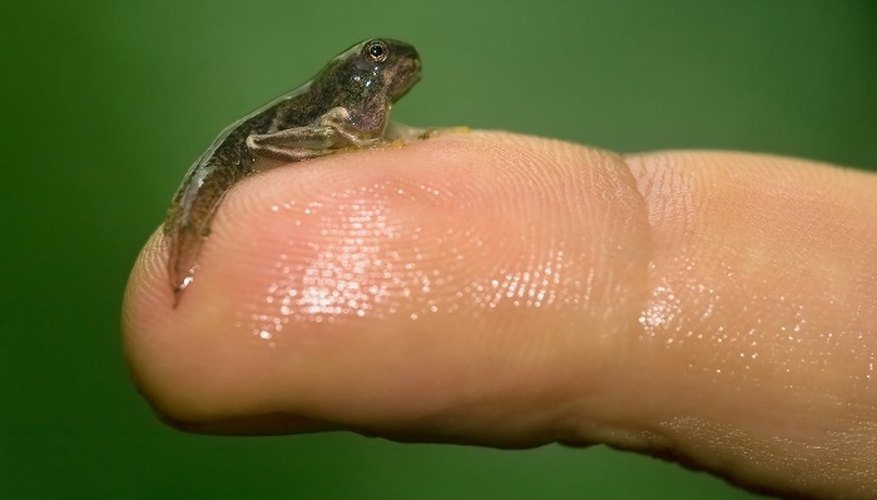Frogs can make interesting pets. To raise a frog from a baby to an adult, you should start with a tadpole, which will metamorphose within a few months into a froglet, or baby frog. With good care, your froglet will grow into an adult frog, which can live up to eight years in captivity. Collect tadpoles from ponds and streams in the spring or buy them captive-bred. No matter what type of tadpoles you have, the metamorphosis, which takes roughly 90 days from egg to full-fledged frog, is fascinating to watch.
- Frogs can make interesting pets.
- To raise a frog from a baby to an adult, you should start with a tadpole, which will metamorphose within a few months into a froglet, or baby frog.
Check with the environment department at your local council to ensure collecting wild tadpoles is not illegal. If so, you can always buy captive-bred tadpoles, which have the advantage of being disease-free. If collecting wild tadpoles, you don't need more than a few.
Use a 45 litre tank of glass or plastic -- complete with a screened cover -- to house your tadpoles. Place a 1.25 cm layer of aquarium pebbles on the bottom and add dechlorinated water to a depth of 5 to 10 cm. Let the treated water sit overnight to get rid of any residual chemicals. Tadpoles are very sensitive to chlorine.
- Use a 45 litre tank of glass or plastic -- complete with a screened cover -- to house your tadpoles.
Landscape the tank with shop-bought aquatic plants, which provide both aeration and hiding places for your tadpoles, and stacks of rocks that tadpoles can use to leave the water when metamorphosis is complete.
Keep the water temperature between 18C and 24C; a heater should not be required if you keep the tank in a place with normal room temperature.
Feed the tadpoles lettuce or spinach that you've washed and boiled for 15 minutes. You also can offer commercial tadpole food and bottom-feeder algae fish food. Supplying small feedings a couple of times a day is preferable to giving one big feeding.
Do a partial change of the water every three days, replacing the dirty water with dechlorinated water. Tadpoles have gills, like fish, and have the same requirements for clean water.
Set up the permanent home when tadpoles have their rear legs and are beginning to develop front ones. To provide the semi-aquatic environment most frogs need, you can use a piece of plexiglass and silicon sealant to divide the tank into a water area and a land area, or simply slope pebbles to form a natural ramp onto the land area, which can be formed by covering gravel with some moss.
Offer the small froglets wingless fruit flues and small worms when they have all four limbs and are spending more time on land than in water. The froglets might still have tails at this point, but they will be absorbed within a day or so. Don't worry if the froglets don't eat for a day or two while their tails are being absorbed -- they are getting some nourishment from their tails. After this, they should be ravenous and attack the insects with gusto.
- Do a partial change of the water every three days, replacing the dirty water with dechlorinated water.
- The froglets might still have tails at this point, but they will be absorbed within a day or so.
Begin offering full-size insects and worms as the froglets develop into mature adults.
TIP
Frogs also do well in garden ponds but may wander away at any time.
WARNING
Be careful when netting the tadpoles and don't handle them at any time. Their skins are sensitive and damage during handling can cause deformities when the tadpoles become adult frogs.
Wash your hands well after handling your frogs.
